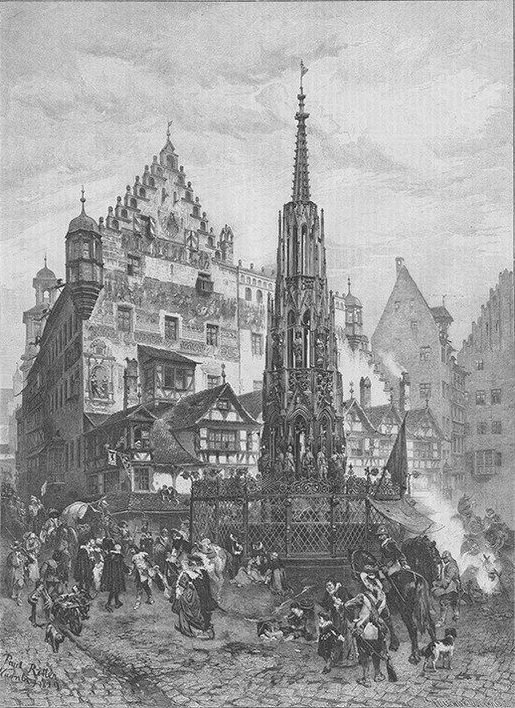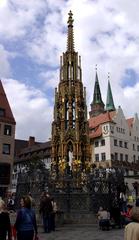
Schöner Brunnen Nuremberg: Visiting Hours, Tickets & Historical Site Guide
Date: 15/06/2025
Introduction
Located in the heart of Nuremberg’s Hauptmarkt, the Schöner Brunnen (“Beautiful Fountain”) stands as a masterpiece of Gothic artistry and a vibrant symbol of the city’s heritage. Commissioned in the late 14th century under Emperor Charles IV, the fountain is renowned for its soaring 19-meter spire, an array of forty vividly painted figures, and the legendary wishing rings embedded in its ornate iron grille. Over centuries, it has survived the ravages of time, weather, and war, remaining a cornerstone of Nuremberg’s cultural and architectural landscape.
This comprehensive guide explores the Schöner Brunnen’s historical origins, architectural features, restoration efforts, and practical visitor information. Discover the meaning behind its symbolic figures, the myths and legends that surround it, and essential tips for making the most of your visit—including accessibility, nearby attractions, and travel recommendations. For official updates, consult the Nuremberg city website and the Nuremberg tourism portal.
Table of Contents
- Introduction
- Historical Origins and Construction
- Architectural and Artistic Features
- Symbolism and Iconography
- Restoration and Conservation
- The Wishing Rings: Legends and Traditions
- Practical Visitor Information
- Rituals and Local Customs
- Frequently Asked Questions (FAQ)
- Visuals and Media
- References
- Conclusion
Historical Origins and Construction
Commissioned between 1385 and 1396, the Schöner Brunnen was designed by Heinrich Beheim, with notable contributions from other medieval craftsmen (Nuremberg Hochbauamt, deinnaemberch.de). Conceived as more than a water source, the fountain was intended to embody the intellectual and spiritual ideals of Nuremberg, a city that flourished as a center of commerce, imperial power, and scholarship during the Holy Roman Empire.
The original structure, built from local red sandstone, showcased the era’s fascination with verticality and ornate detail. Its form, reminiscent of a church spire, underscores the city’s aspirations and piety. Due to the fragility of sandstone, repeated restorations became necessary. In the early 20th century, a faithful replica was constructed from durable shell limestone (Muschelkalk), securing the fountain’s future for generations to come (nuernberg.de).
Architectural and Artistic Features
Structure and Layout
The Schöner Brunnen rises approximately 19 meters from an octagonal base, surrounded by a richly decorated wrought-iron fence. Its four ascending tiers are adorned with intricate tracery, crockets, pinnacles, and forty painted stone figures, each loaded with symbolic meaning (deinnaemberch.de).
Artistic Highlights
- First Tier: Philosophy and the Seven Liberal Arts (Grammar, Rhetoric, Logic, Arithmetic, Geometry, Music, and Astronomy), laying the foundation of medieval education.
- Second Tier: The Four Evangelists and the Four Church Fathers, representing the pillars of Christian doctrine.
- Third Tier: The Seven Electors and the Nine Worthies, embodying secular and chivalric virtues.
- Top Tier: Moses and the Seven Prophets, symbolizing the roots of Judeo-Christian belief.
The fountain’s figures are vividly painted in the tradition of medieval polychromy, restored over the centuries to preserve their original splendor. The uppermost level is crowned by a golden finial and a statue of Moses, holding the tablets of the law.
Symbolism and Iconography
The Schöner Brunnen is more than decorative; it is a sculptural representation of the medieval worldview (de.wikipedia.org). Each tier encapsulates a different domain of knowledge, power, or faith, reflecting the city’s role in the Holy Roman Empire as a nexus of learning and governance.
The inclusion of both secular and sacred figures illustrates the intertwined nature of church and state, while the gargoyles at the base—depicting the seven deadly sins—serve as a reminder of moral responsibility. Together, these elements create a visual encyclopedia of medieval thought.
Restoration and Conservation
Early Challenges and 19th-Century Restoration
The original sandstone construction, though visually striking, proved vulnerable to weathering. By the late 19th century, the Schöner Brunnen required comprehensive restoration. Between 1898 and 1903, it was carefully dismantled and rebuilt using shell limestone, preserving its Gothic form while enhancing durability (Nuremberg Hochbauamt).
21st-Century Conservation
Routine inspections in the 2010s revealed new structural challenges, including algae growth, cracks, and paint loss. A major restoration launched in 2015 utilized advanced 3D scanning, internal steel reinforcements, improved drainage, and state-of-the-art lighting. The project concluded in 2016, earning praise for its blend of tradition and innovation.
During World War II, the fountain was encased in concrete, a decisive action that protected it from bombing damage (de.wikipedia.org).
The Wishing Rings: Legends and Traditions
A central attraction of the Schöner Brunnen is the pair of “wishing rings” set into its iron grille—one golden, one black. According to local legend, spinning the seamless golden ring three times while making a silent wish will bring good luck (explorial.com; frankensein.de). Folklore suggests the ring was ingeniously forged by a young apprentice seeking to prove his mastery and win the hand of his beloved (englishpost.de).
The tradition endures: visitors from around the world line up to turn the ring and make a wish, connecting modern travelers to centuries of Nurembergers who have done the same.
Practical Visitor Information
Visiting Hours and Tickets
- Opening Hours: Schöner Brunnen is outdoors and accessible 24/7, year-round.
- Tickets: No entrance fee or ticket is required; visiting is free of charge.
- Guided Tours: Many local operators offer walking tours that include the fountain. The Nuremberg Tourist Information office provides up-to-date schedules (tourismus.nuernberg.de).
Accessibility
- The Hauptmarkt is paved and mostly flat, ensuring wheelchair and stroller access.
- Benches and accessible restrooms are available nearby.
Getting There
- Address: Hauptmarkt, 90403 Nürnberg, Germany
- Public Transport: U-Bahn Lorenzkirche (U1 line), plus tram and bus stops at Hauptmarkt and Rathaus.
- Parking: Public garages such as Parkhaus Hauptmarkt and Parkhaus Adlerstraße are within walking distance.
Nearby Attractions
- Frauenkirche: Gothic church with daily “Männleinlaufen” clock show.
- Nuremberg Castle (Kaiserburg): Medieval fortress with city views.
- Albrecht Dürer’s House: Museum dedicated to the Renaissance artist.
- Germanisches Nationalmuseum: Germany’s largest museum of cultural history.
- Weißgerbergasse: Picturesque half-timbered houses.
- Handwerkerhof: Recreated medieval crafts village.
- Christkindlesmarkt: World-famous Christmas market from late November to December 24 (cntraveller.de).
Photography Tips
- Visit early morning or late afternoon for optimal lighting.
- Capture close-ups of the painted figures and the wishing rings.
- Use a wide-angle lens for full views of the fountain and Hauptmarkt.
Rituals and Local Customs
Spinning the golden wishing ring is the most popular tradition, but the fountain also serves as a gathering point during festivals, markets, and city events. During the Christkindlesmarkt, the illuminated fountain becomes a festive centerpiece. Locals recommend early or late visits for a quieter, more contemplative atmosphere (lonelyplanet.com).
Frequently Asked Questions (FAQ)
Q: What are the Schöner Brunnen visiting hours?
A: The fountain is accessible at all times; best viewed during daylight.
Q: Is there an entrance fee or ticket required?
A: No, the site is free to visit.
Q: Is the site wheelchair accessible?
A: Yes, the Hauptmarkt is paved and flat.
Q: How do I reach Schöner Brunnen by public transport?
A: Use the U-Bahn Lorenzkirche (U1 line) or trams/buses to Hauptmarkt or Rathaus.
Q: Can I spin the wishing ring?
A: Yes, spinning the golden ring three times while making a wish is encouraged.
Q: What are the best times to visit?
A: Early mornings or late afternoons for fewer crowds and better lighting.
Q: Are guided tours available?
A: Yes, check with the Nuremberg Tourist Information office for options.
Visuals and Media
For more images and virtual tours, see the official tourism site.
References
- Nuremberg Hochbauamt – Schöner Brunnen
- deinnaemberch.de – The Wishing Ring and Fountain Legends
- nuernberg.de – Schöner Brunnen Official Info
- tourismus.nuernberg.de – Visitor Information
- explorial.com – Schöner Brunnen Sights & Legends
- frankensein.de – Myths and Legends
- englishpost.de – Beautiful Fountain Legend
- de.wikipedia.org – Schöner Brunnen
- lonelyplanet.com – Schöner Brunnen Attraction
- cntraveller.de – Nuremberg Sights
Conclusion
The Schöner Brunnen is a living testament to Nuremberg’s medieval heritage, architectural prowess, and enduring traditions. Its intricate design, symbolic figures, and the magic of the wishing ring offer visitors a unique journey through centuries of history and folklore. Freely accessible in the bustling Hauptmarkt, the fountain is a highlight of any visit to Nuremberg—especially when combined with guided tours and visits to nearby historical sites.
For the most enriching experience, plan your visit during daylight hours, spin the golden ring, and join a walking tour for deeper insights. To explore more, download the Audiala app for guided audio tours and stay updated through local tourism channels. Discover the Schöner Brunnen—where legend, art, and history converge in the heart of Nuremberg.
















































